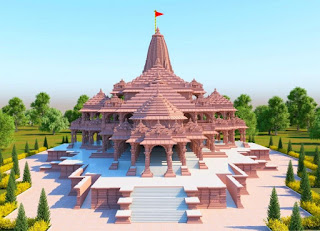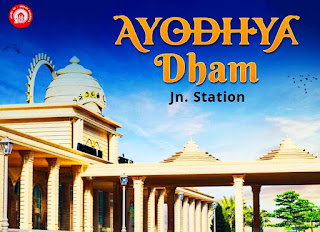A GLITTERING NEW TEMPLE FOR LORD RAM AT
AYODHYA
The Prana
Pratishta (consecration) of a majestic statue of Ram Lalla (Bhagwan Ram as a
child) in a grand new temple at Ayodhya, the deity’s birthplace in Uttar
Pradesh, on January 22, 2024, proved to be an event of great grandeur. The colourfully flower-bedecked temple was a
spectacle for adoration and admiration. The
occasion was marked by an overwhelming display of devotional fervour by a
multitude of people at the venue, elsewhere in the country and abroad.
(By Subbaram Danda)
Prime
Minister Narendra Modi played a leading role in conducting elaborate consecration
rituals in the Garbagriha (sanctum sanctorum) of the temple, assisted by Vedic
scholars. He was accompanied by RSS
Chief Mohan Bhagwat, UP Governor Anandiben Patel and Chief Minister Yogi
Adityanath. At the end of it all, Prana
Pratishta attained fruition. Earlier, on January 18, the new statue was
shifted from the place where it was sculpted to the Garbagriha and installed
there after preliminary rituals. The sculptor of the idol is Arun Yogiraj from Karnataka. He called himself "the luckiest person on earth."
The new Ram Lalla statue, made of Shyamal (dark) stone, stands gracefully on a gold-plated pedestal, with a smiling face, chubby cheeks, serene eyes and a radiant tilak on the forehead. The richly ornamented, tastefully attired and colourfully garlanded 51-inch idol holds a bow in the left arm, an arrow in the right and a quiver on the back. The small old idol of Ram Lalla, which was all along being worshipped in a separate abode, was also placed in front of the new statue. It is intended to be the utsav murthi.
Among the 7,000 invitees were many seers and prominent personalities representing the wide spectrum of the Indian society. Select overseas celebrities were also present. The historic event was telecast live throughout India and in several foreign countries. It was a big draw at the iconic Times Square in New York city, where it was live streamed.
The three-storey main temple standing on a raised platform with five mandaps is a magnificent marvel with spectacular features. Built in the Nagara style, its architecture reflects the rich heritage of Bharat. The sculptures of deities and celestial figures on walls and pillars as also the artworks and carvings on ceilings and floors are bound to delight the devotees. The temple complex spreads massively over 67 acres. The main structure is 161 feet tall at its highest point, 380 feet long from east to west and 250 feet wide from south to north.
Above all, what mesmerizes everyone is that all the temple’s 44 teakwood doors will be gold-plated. Distinctive designs have been conceived for the doors of the sanctum sanctorum and of the shrines of deities Sita, Lakshmana and Hanuman elsewhere. Several gold-plated doors, including the ones for the sanctum, have already been installed.
An awesome highlight is that at noon on Sriram Navami day every year a beam of sunlight will cast a brilliant tilak on the forehead of the idol in the sanctum sanctorum. This Surya tilak phenomenon will, however, last only a short period. It will all be made possible by a device mounted on the shikara of the temple. For the execution of this project, two reputed institutes, one specializing in astrophysics and the other in building research, have been roped in. Further, meticulous attention has been paid to the temple lighting, which has been customized for every inch of space. One outcome is that in the night the entire structure dazzles colourfully.
According to the Ram Janmabhoomi Teerth Kshetra Trust, which manages all temple affairs, there would not be any necessity for repairs to the temple for a thousand years and more. Very deep foundation has been laid primarily with stones and compacted cement. No steel or iron has been used either in the foundation or in the super structure. Because of these special measures, the temple will be able to withstand an earthquake of even a very high magnitude.
The entry to the temple is from the east. After passing through the simhadwar, the devotees have to climb 32 steps. As they walk up, they can see on either side of the steps the figures of an elephant and a lion. Finally, there will be a statue of Hanuman on one side and of Garuda on the other. In the main temple on the first floor, Darbar of Shri Ram will come up. A rectangular parikrama pathway of about 2,400 feet in length and 14 feet in width will surround the temple on all sides. Shrines dedicated to Surya, Bhagavati, Ganesha and Shiva will be constructed at the four corners of the parikrama. Also, Valmiki, Vasishta, Vishwamitra, Agastya, Nishad raj, Sabari and Ahalya will have their abodes in the complex.
A water metro is a novel facility that Ayodhya will have. It is a unique ferry service cruising on the Sarayu river, whose water front has undergone a major makeover. A 50-seater air-conditioned craft will sail between two selected ghats on the river providing an extensive view of the city to the visitors. The riverbanks are also the sites for regular laser shows and Aarthis.. More gratifying is the fact that over 200 developmental projects with a large outlay have been taken up. All these are designed to bring about what is described as “the biggest transformation of the ancient city.” On completion, Ayodhya is expected to become “the most beautiful city in the world.”
The entire ancient city is being spruced up. Many of the roads now wear an attractive look with arches, art works and ornamental lights. The Dharma path, one of the four new roads, features large rectangular brick boards put up at intervals on either side that showcase Ramayana paintings. A long decorative arch gracefully spans the entire width of the broad Dharma path at a vantage point. At the centre of the arch shines an imposing cut-out of the Sun God riding seven horses. Further, Surya themed designer lamp posts with a big spherical yellow bulb at the top flank the road. All this is intended to represent symbolically that Lord Ram belongs to Surya vamsa.
Nearby, a picturesque chowk displays a huge, exquisite replica of the Indian classical musical instrument Veena. Mounted high on a circular base, it attracts celebrities as well as commoners. It has become a much sought after selfie backdrop for all visitors. To enhance the beauty of the city further, numerous parks have been laid out that are illuminated at night by solar power.
The other major projects include expansion and modernization of an existing airstrip, upgradation of the railway station, introduction of an intelligent traffic management system, renovation of old temples in the ancient city and revival of more than 108 ponds. Further, work has also been initiated for development of a Ramayana circuit with the intention of making the city an 'epicentre of devotion' for visitors from all over the world.
On December 30, 2023, the Prime Minister inaugurated the first phase of the modern airport called Maharishi Valmiki International airport and the revamped railway station named the Ayodhya Dham junction. Carved pillars, ornamental gateways and attractive murals depicting anecdotes from the Ramayana mark the architecture of the airport and the railway station. Their facade reflects the hoary heritage of Ayodhya.
No wonder, with all these incredible developments Ayodhya will surely be shining brilliantly for a long time not only as a spiritual centre but also as a major tourist attraction.
January 22, 2024
***


.jpeg)
.jpeg)
.jpeg)





.jpeg)



